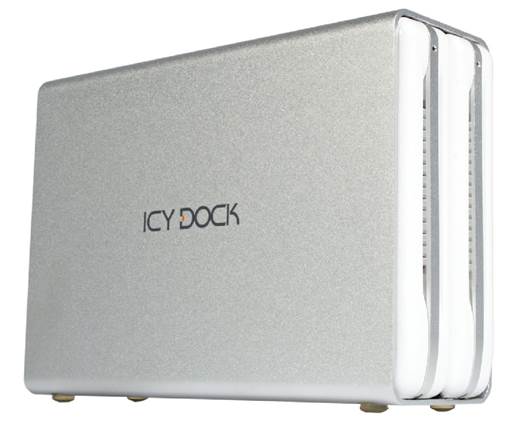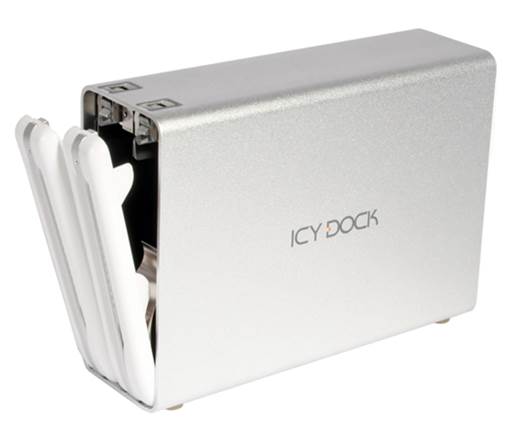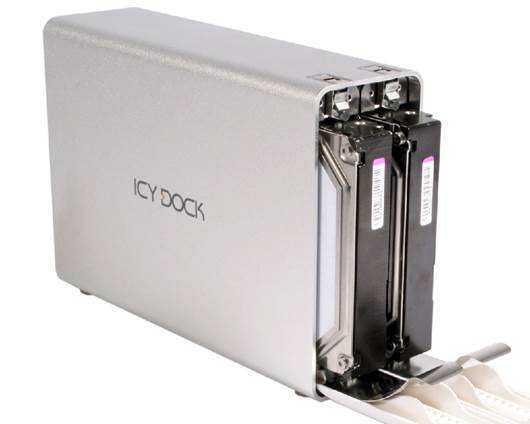This new HDD enclosure is costly but
comes with a few tricks
External hard drive enclosures are nothing
new, and they provide a cheap way to turn an old hard disk into portable
storage. The new ICYRaid MB662U3-2S from Icy Dock, however, is a little
special. Not only is it USB 3.0 enabled and capable of holding dual 3.5"
drives, it can also run them in RAID arrays. This means that there are very few
competing products on the market, but the $176.7 estimated price is still a
hefty sum of cash to part with given that it doesn't include any drives.
The ICYRaid enclosure is built to last, and
the metal it's made from, especially the aluminum body, is solid and very
sturdy.

Icy
Pock ICYRaid MB662U3-2S
It's also slim and lightweight, and
features an aesthetic akin to Apple products. It's designed to stand vertically
on its rubber feet, and though these provide excellent grip, it wouldn't take
too much of a knock to topple it and cause potentially fatal data loss.
Keeping your drives cool is a single rear
40mm exhaust fan, the speed of which can be controlled by a dial. Even at
maximum speed it's not intrusively loud, but the dial is difficult to reach
without very skinny fingers or long nails due to the indented rear panel.
Drives also receive passive cooling from the heat conducting aluminum body.
As well as the fan, the power supply input
and other connectivity is all found on the rear panel, where the power and
reset switches are joined by a USB 3.0 port. The front LEDs, which are used to
show drive access and drive failure, can be disabled here, as can the device's
power save mode. Finally, the RAID switch, which is also difficult to flick,
lets you configure how your drives are addressed. You can set them as separate
volumes (JBOD), as a single merged volume (BIG) or as striped RAID 0 or
mirrored RAID 1 volumes.
You can install drives of up to 4TB
capacity in each bay, and doing so simply requires you to pop the bay open with
a button, slide the drive in and close the bay cover to lock it in place. The
drive trays and cages are a little wobbly but should be fine for multiple uses
if you're careful.

You
can install drives of up to 4TB capacity in each bay, and doing so simply
requires you to pop the bay open with a button, slide the drive in and close
the bay cover to lock it in place.
Hot swapping drives is supported, and
changing the RAID mode is as simple as flicking the back switch and hitting the
reset button. There's no extra software or drivers to deal with, so the
enclosure is incredibly user friendly.
To test the performance of the enclosure, I
used two Seagate Barracuda 7200.11 1TB drives. I ran benchmarks on the drives
in JBOD, RAID 1 and RAID 0 mode and compared these to benchmarks on single
drive and RAID 0 set-ups mounted internally to a motherboard via SATA 6Gbps to
test for performance loss via the USB controller.
Sequential read and write speeds for the
drives tested max out at around 113MB/S and 106MB/S respectively, and
thankfully the ICYRaid enclosure keeps pace with these speeds when addressing
single drives or a RAID 1 setup, indicating minimal performance loss here.
However, whereas a desktop RAID 0 setup sees double the performance of a single
drive, the RAID 0 configuration in the enclosure sees scaling here of around
65%, indicating some performance loss. The speed boost over a single drive is
still very significant, however.
Random performance is more of a mixed bag.
Whereas 512KB random read speeds are spot on in all arrangements, write speeds
suffer somewhat compared to internally mounted drives. 4KB random rear and
write performance is on par with what you'd expect of drives mounted
internally, but unfortunately these speeds are still on the slow side.
The PCMark 7 secondary storage test
simulates real world workloads (but is still a synthetic benchmark), and here
internal SATA drives are favored over those connected via the Icy Dock
enclosure, and RAID 0 in particular loses its speed advantage.

However,
if your lifestyle means it's very important that your data is both portable but
also constantly backed up, the RAID 1functionality is especially useful, and
the enclosure has enough build quality, good looks and ease of use to make it
worth considering
Overall, there are relatively few
performance hits when using the MB662U3-2S to house your drives, and single
drive and RAID 1 setups are particularly good at maintaining the speeds
you'd see with internally housed drives, which is excellent given that the
enclosure gives you the freedom of portability (you will need a power socket to
use it, however). The USB 3.0 interface is another real bonus and one the
enclosure makes good use of, as USB 2.0 would be very limiting.
The MB662U3-2S enclosure is undoubtedly a
niche product, and the price makes it even more so. If you just need a basic
enclosure for storage purposes, there are plenty of cheaper and more viable
alternatives.
However, if your lifestyle means it's very
important that your data is both portable but also constantly backed up, the
RAID 1functionality is especially useful, and the enclosure has enough build
quality, good looks and ease of use to make it worth considering.
|
Details
·
Price: Approx. $17
·
Manufacturer: Icy Dock
·
Website: www.icydock.com
·
Required spec: One USB 3.0 port
|